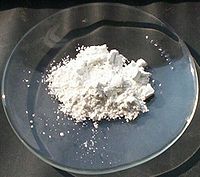삼산화 안티모니

| |
| 이름 | |
|---|---|
| IUPAC 이름
Antimony(III) oxide
| |
| 별칭 | |
| 식별자 | |
3D 모델 (JSmol)
|
|
| ChemSpider | |
| ECHA InfoCard | 100.013.796 |
| EC 번호 |
|
| KEGG | |
PubChem CID
|
|
| RTECS 번호 |
|
| UNII | |
CompTox Dashboard (EPA)
|
|
| |
| |
| 성질 | |
| Sb2O3 | |
| 몰 질량 | 291.518 g/mol |
| 겉보기 | white solid |
| 냄새 | odorless |
| 밀도 | 5.2 g/cm3, α-form 5.67 g/cm3 β-form |
| 녹는점 | 656 °C (1,213 °F; 929 K) |
| 끓는점 | 1,425 °C (2,597 °F; 1,698 K) (sublimes) |
| 370 ± 37 µg/L between 20.8 °C and 22.9 °C | |
| 용해도 | soluble in acid |
자화율 (χ)
|
-69.4·10−6 cm3/mol |
굴절률 (nD)
|
2.087, α-form 2.35, β-form |
| 구조 | |
| cubic (α)<570 °C orthorhombic (β) >570 °C | |
| pyramidal | |
| zero | |
| 위험 | |
| GHS 그림문자 |  [1] [1]
|
| 신호어 | 경고[1] |
| H351[1] | |
| P281[1] | |
| NFPA 704 (파이어 다이아몬드) | |
| 반수 치사량 또는 반수 치사농도 (LD, LC): | |
LD50 (median dose)
|
7000 mg/kg, oral (rat) |
| NIOSH (미국 건강 노출 한계): | |
PEL (허용)
|
TWA 0.5 mg/m3 (as Sb)[2] |
REL (권장)
|
TWA 0.5 mg/m3 (as Sb)[2] |
| 관련 화합물 | |
다른 음이온
|
Antimony trisulfide Antimony triselenide Antimony telluride |
다른 양이온
|
Dinitrogen trioxide Phosphorus trioxide Arsenic trioxide Bismuth trioxide |
관련 화합물
|
Diantimony tetraoxide Antimony pentoxide |
달리 명시된 경우를 제외하면, 표준상태(25 °C [77 °F], 100 kPa)에서 물질의 정보가 제공됨.
| |
삼산화 안티모니(Antimony trioxide)는 화학식 Sb2O3을 갖는 무기 화합물이다. 가장 중요한 상업용 안티모니 화합물이다. 광물 발렌티나이트와 세나모나이트를 통해 자연에서 발견된다.[3] 대부분의 이량체 산화물처럼 Sb2O3은 가수분해와 함께 수용액에 녹는다.
이용[편집]
미국과 유럽 내 삼산화 안티몬 소비량은 각각 약 10,000 및 25,000톤이다. 주로 할로겐화 물질들과 결합하여 난연제(내화처리제) 공력제로서 사용된다. 이러한 난연제는 전자기기, 직물, 가죽, 코팅에서 볼 수 있다.[4]
안전[편집]
삼산화 안티몬은 인간에 영향을 주는 잠재적인 발암물질로 의심을 받고 있다.[4] 이 물질로 인해 어떠한 인간의 건강에 대한 위험이 식별되지 않았고 일상 생활에서 삼산화 안티몬을 생산하고 이용 시 어떠한 인간의 건강 및 환경적 위험이 식별되지 않았다.
각주[편집]
- ↑ 가 나 다 라 Record of Antimony trioxide in the GESTIS Substance Database of the Institute for Occupational Safety and Health, accessed on 23 August 2017.
- ↑ 가 나 NIOSH Pocket Guide to Chemical Hazards. “#0036”. 미국 국립 직업안전위생연구소 (NIOSH).
- ↑ Greenwood, N. N.; & Earnshaw, A. (1997). Chemistry of the Elements (2nd Edn.), Oxford:Butterworth-Heinemann. ISBN 0-7506-3365-4.
- ↑ 가 나 Grund, S. C.; Hanusch, K.; Breunig, H. J.; Wolf, H. U., 〈Antimony and Antimony Compounds〉, 《울만 공업화학 백과사전(Ullmann's Encyclopedia of Industrial Chemistry)》, Weinheim: Wiley-VCH, doi:10.1002/14356007.a03_055.pub2

